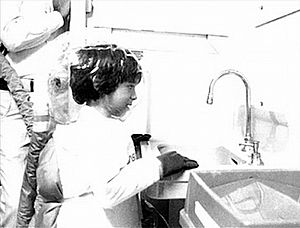David Vetter facts for kids
Quick facts for kids
David Vetter
|
|
|---|---|
 |
|
| Born |
David Phillip Vetter
September 21, 1971 Houston, Texas, U.S.
|
| Died | February 22, 1984 (aged 12) Dobbin, Texas, U.S.
|
| Cause of death | Lymphoma; complications from SCID |
| Resting place | Conroe, Texas, U.S. |
David Phillip Vetter (born September 21, 1971 – died February 22, 1984) was an American boy. He became famous because he had a very rare illness called severe combined immunodeficiency (SCID). This disease made his body unable to fight off germs. Even common germs could make him very sick. Because of this, David had to live inside a special germ-free bubble. People often called him "David, the bubble boy." His family's last name was kept secret for many years to protect their privacy.
David spent his early years in a hospital in Houston, Texas. Later, he spent more time at home with his parents and sister, Katherine. He passed away in 1984 when he was 12 years old.
David's Family and Early Life
David's parents were Carol Ann and David Joseph Vetter, Jr. Their first son, also named David, was born with SCID. He sadly passed away when he was only seven months old. Doctors told David's parents that any future sons they had would have a 50% chance of getting the same disease.
At that time, the only way to help children with SCID was to keep them in a germ-free place. They would stay there until they could get a successful bone marrow transplant. David's parents, who also had a daughter, decided to have another child. David Phillip Vetter was born on September 21, 1971.
A special germ-free bed, like a cocoon, was ready for David when he was born. Right after he was born, David entered this plastic, germ-free environment. This "bubble" would be his home for most of his life. David was baptized as a Roman Catholic with sterilized holy water once he was safely inside the bubble. Doctors hoped to do a bone marrow transplant soon. However, tests showed that David's sister, Katherine, was not a good match to be a donor.
Life Inside the Bubble
Everything that went into David's germ-free chamber had to be sterilized. This included water, air, food, diapers, and clothes. Items were placed in a special chamber filled with gas for four hours. Then, they were aired out for several days before entering David's bubble.
David could only be touched through special plastic gloves. These gloves were attached to the walls of his chamber. The air compressors that kept the bubble inflated were very loud. This made it hard to talk with David. His parents and medical team, including Dr. John Montgomery, tried to give him a normal life. He had a formal education, a television, and a playroom inside his sterile home.
About three years after David was born, another sterile chamber was built. This one was at his parents' home in Conroe, Texas. A special transport chamber was also made. This allowed David to spend two or three weeks at home with his sister and friends. A friend even arranged a special movie showing of Return of the Jedi. David could attend the movie in his transport chamber.
When David was four years old, he found a way to poke holes in his bubble. He used a butterfly syringe that was left inside by mistake. After this, his medical team explained what germs were. They taught him how germs could affect his health. As he grew older, David became more aware of the world outside his bubble. He wanted to be part of what he saw through the windows and on TV.
In 1977, scientists from NASA helped David. They used their experience making space suits to create a special suit for him. This suit allowed David to leave his bubble and walk outside. The suit was connected to his bubble by a long cloth tube. It was a bit clumsy, but it let him go outside safely. David was not sure about the suit at first. He later became more comfortable wearing it. However, he only used it seven times. He grew out of the suit and never used the replacement one NASA made for him.
David's Final Days
About $1.3 million was spent on David's care over the years. Scientists worked hard, but they could not find a cure for SCID. No perfect donor match was found for him either. Later, David received a bone marrow transplant from his sister, Katherine. His body did not reject the transplant. However, he became sick with infectious mononucleosis a few months later.
David passed away 15 days later, on February 22, 1984. He was 12 years old. The cause of his death was a type of cancer called Burkitt's lymphoma. He was buried in Conroe, Texas, next to his older brother.
David's Legacy
A school in The Woodlands, Texas, was named David Elementary after Vetter. It opened in 1990.
The song "The Boy in the Bubble" by Paul Simon was inspired by David Vetter's story.


